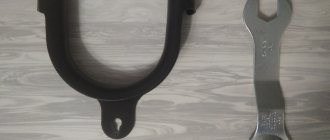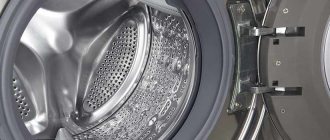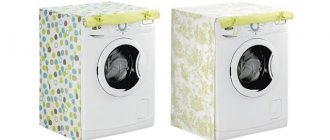Hi all! I think you will agree that for a modern person, a washing machine has become an indispensable component of a comfortable life. The only problem is that many people have a very small bathroom. For example, you can look at the bathroom in a Khrushchev building and understand that there is clearly not enough space for a washing machine.
When the question arises about where it is better to place the machine - in the kitchen or in the bathroom, you definitely shouldn’t skip the kitchen option. Yes, this placement has its pros and cons, pros and cons, which can be offset by the right approach to the task.
I propose to talk about how a washing machine fits well in the kitchen, and what options there are for placing this household appliance. Don’t be embarrassed by even having a washing machine and a dishwasher in the same room at the same time. Proper planning and rational use of kitchen space will allow you to achieve excellent results.
Seamless integration of the washing machine in the kitchen
Washing machine in kitchen design
Most people agree that SMA in the kitchen can ruin the design, but many find it a very convenient solution. There are thousands of layout options. With a skillful approach, you will not spoil the design of the room, but will only transform it favorably. If you have questions about how to install the machine so that the appearance of the kitchen does not deteriorate, we will help you with this. Of course, it is initially necessary to think through such an installation, and not just put the washing machine in the corner and calmly exhale. In this situation, it is necessary to select a machine to match the interior. The best option is to install the washing machine during the main design.
Under-table installation
Don't know how to integrate a washing machine under the countertop? There's nothing complicated about it. It is recommended to order a furniture set that matches the required dimensions of your machine. In this case, the equipment will be hidden, and you will get an additional countertop. You can also make a corner kitchen. In this case, the machine built under the countertop will not interfere with movement around the room.
Built-in Model Options
You can also integrate a regular washing machine into the kitchen. To do this, you will need to make a furniture frame for the machine, which will fit perfectly into the interior and not differ from the main set. The main thing in this matter is to turn on your imagination and make all your desires come true.
How to dismantle the top panel on PMM of different brands?
Let's look at the procedure for dismantling the panel in cars from leading brands.
Instructions for Bosch and Whirlpool
The easiest way is with a Bosch dishwasher. Proceed like this:
The manual for Whirlpool machines is similar - the top panel is also held in place by plastic latches.
Manual for Indesit and Hotpoint Ariston
The procedure is almost the same, with minor differences:
On a note! It is very important for the further validity of the warranty card that the procedure for removing the cover is regulated by the manufacturer. If the manufacturer does not indicate the possibility of dismantling, then by removing the panel you will lose the warranty and the possibility of free service in the event of a breakdown.
Procedure for Beko brand PMM
Your actions and rules for their implementation:
In some Beko models, the top cover can only be removed together with the back panel. In this case, work is carried out like this:
Advantages and disadvantages of installation
Will the washing machine be in the way in the kitchen? It's difficult to give a definite answer. For some, this arrangement is not a hindrance, but for other people it is unacceptable. And in most cases, the kitchen area plays a huge role. Therefore, it is worth considering in detail the positive and negative aspects when installing a machine in the kitchen. Let's start with the advantages:
- You don't have to install the machine in the bathroom, which means there will be much more space there.
- You can perform several actions at the same time. The washing is going on, and you are cooking. In this case, you don’t have to drop everything and run to the bathroom to monitor the washing process.
- Due to the fact that there is more space in the kitchen, you can without a doubt purchase a full-sized washing machine. The space in some bathrooms does not allow for a large and capacious machine.
Flaws:
- It is unlikely that you will be throwing dirty laundry around in the kitchen. You can install a special basket for this in the bathroom. In the kitchen there is nowhere to place a linen drawer or basket.
- There is also no place to store household chemicals in the kitchen. Moreover, storing powders near food is a risky business. This means you have to run to the bathroom before every wash.
- Kitchen appliances can often get dirty. Therefore, the occurrence of greasy stains and drips is normal.
- Difficulties may arise when installing vertical type washing machines. You will have to order a cabinet with a folding tabletop - this is very inconvenient.
You see that there are more minuses than pluses, but this should not scare you. For example, a separate niche in the kitchen unit is suitable for storing washing detergents and a basket with dirty laundry. The same applies to stains that occur during cooking. If the niche is covered with doors, nothing will get on the body of the machine.
Recommendation! Installing a washing machine in the kitchen will significantly save space in the bathroom. Have you dreamed of a Jacuzzi or a large shower? Send SM to the kitchen and the bath is yours.
Procedure for removing the machine
It is not recommended to rush to dismantle the built-in washing machine. It is necessary to act in a certain sequence, preparing and disconnecting the equipment from communications. Ideally, you should call an assistant - the machine weighs 50-80 kg and is pulled out in a very awkward position. In order not to drop the unit, it is better to “attract” extra workers. Before removing the equipment, you must perform the following procedures:
- disconnect the built-in machine from the power supply;
- fix the power cord on the body of the washing machine so that it does not interfere with dismantling;
- turn off the water by turning the pressure tap;
- unscrew the inlet hose from the water pipe, drain the water from it and secure it to the body;
- disconnect the drainage hose from the siphon or sewer riser (be sure to drain the water and fix it on the machine);
- remove additional fasteners (sometimes workers, when installing equipment, screw in holders to make the machine more stable);
- get rid of the front projection of the niche (without it, getting the machine gun is much easier);
- Screw the legs of the washing machine to the minimum height.
Before dismantling the built-in washing equipment, it is necessary to disconnect it from the communications and unscrew the additional fasteners.
Having prepared the equipment, you can begin dismantling. You need to open the washing machine door and grab its front wall at the top of the hatch. Then you should lift the machine, simultaneously moving it towards you. If something interferes, then it is prohibited to use force - it is better to inspect the body of the washer again and find out what it clings to. Then the unit will leave the niche without damage or surprises.
To make it easier for the machine to “slide” to the exit, it is recommended to place an old cloth under the legs of the machine. This move will also protect the flooring - otherwise heavy equipment will scratch the linoleum or tiles.
Choosing a washing machine
Today, buyers choose not only functional, but also compact equipment. They initially look at the size of the model, and then at the technical characteristics and features.
Often the choice of SMA depends on how large your room is. For a spacious kitchen, a full-sized machine is perfect, which guarantees ease of use. But it may not fit into the design. If the kitchen is very modest in size, then it is more appropriate to select compact models. Narrow machines will fit even in Khrushchev’s kitchens. It’s easy to hide a “slender” machine in a kitchen unit. Installing the machine under the sink is also suitable. Washing clothes and washing dishes at the same time is a very convenient placement.
If you are accustomed to perfection and unity of style, then the ideal solution is to purchase a built-in machine. You can completely embed the SM, or you can hide it in a furniture set so as not to attract unnecessary attention.
Preparing the machine for transportation
Rarely does a dismantled washing machine go straight to a landfill. More often, it requires further transportation to transport the equipment to the country, to a service center for repairs, or to a new owner after sale. In any case, the machine must be prepared for moving. Otherwise, you can damage the key components of the washing machine due to machine shaking. The first step is:
- drain all the water from the machine through a garbage filter (there is always some liquid left at the bottom of the tank and in the pipes, which must be removed before transportation);
- fix the hoses on the body (the manufacturer has provided special grooves and clamps);
- close the hatch door (so that the hinges do not become loose);
- cover the powder receptacle with tape (otherwise it will fall out of the body and get in the way);
- Wrap all protrusions and corners with paper or a rag (ideally, use a foam frame).
Before transporting the washing machine, it is recommended to screw the shipping bolts through special holes on the rear panel of the case - they will secure the tank and protect shock absorption.
The next step is to fix the tank in a stationary position. It is best to screw the transport bolts into the machine, which come with any washing machine and are removed before its first start. If the rods are not preserved, then you will have to protect the drum in a less reliable and labor-intensive way:
- remove the top cover of the case by unscrewing the retaining bolts;
- fill the empty space between the tank and the body with soft material (foam, foam rubber, textile);
- return the cover to its place.
At the “finish”, the washing machine is completely wrapped in fabric and tied with rope. The machine is now ready for transportation.
Installing a washing machine in the kitchen: features
As for full-sized and built-in equipment, they are absolutely identical in installation. But there are several nuances that should be taken into account when choosing a furniture module:
- If you decide to store detergents in the kitchen, choose a module 25 cm wider - this will allow you to place household chemicals between the cabinet wall and the machine.
- It is necessary to leave a small distance on all sides. The washing machine may vibrate and wobble, it needs space.
- The SM must be installed on a perfectly flat surface.
- For ease of maintenance and repair, it is necessary that the cabinet does not block access to the rear wall and drain filter.
- When installing another built-in appliance, it is recommended to install the washing machine through several cabinets. The automatic machine and the stove should not stand next to each other.
Be sure to think about the layout and placement of equipment in advance. Moving a machine is more difficult than installing it, so take your time with the decision and think it through carefully. After purchasing, you need to figure out how to install and connect the SMA. The connection takes place inside the cabinets. If you are not sure that you can handle it yourself, contact an experienced specialist.
Don’t neglect the option of installing a machine in the kitchen. It is not only convenient, but also harmonious and beautiful.
Top Loading Models
If the “vertical” cover is broken (for example, hinges, lock, powder receptacle), it can also be dismantled.
The first stage is preparation:
The second stage is dismantling the control panel:
Unfastening the panel will give you access to the bolts that hold the moving part in place. Unscrew them and you're done!
How to disassemble the top of the vertical SM can be found here:
As you can see, the process does not take much time and does not require expensive, rare equipment. A suitable screwdriver in skillful hands - and it's done.
Source










